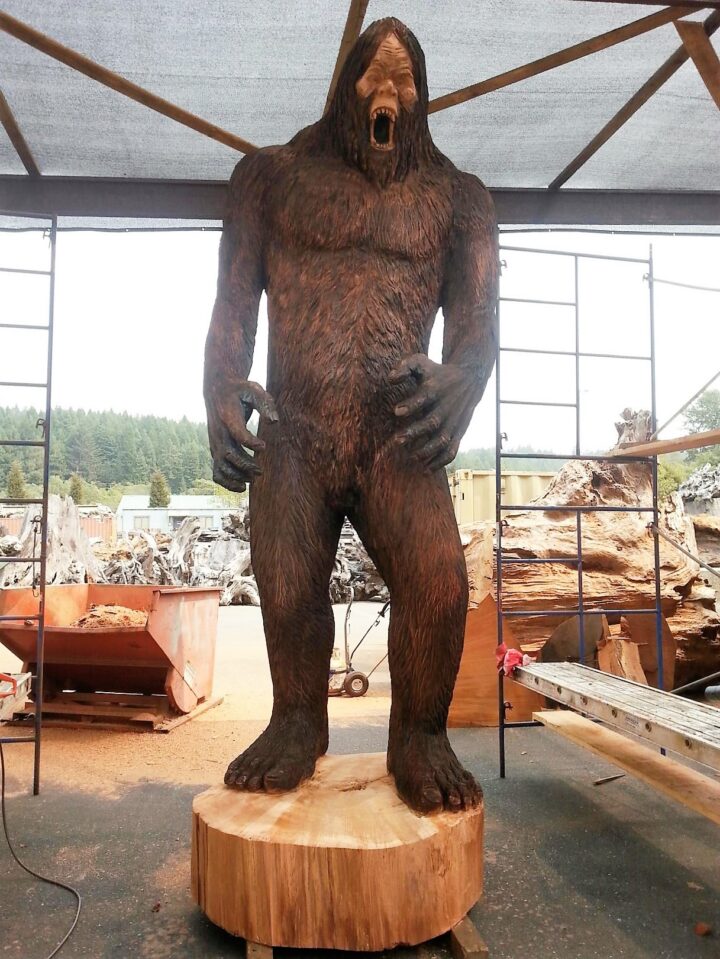
The History
Starting over sixty years ago, Bigfoot has been an intriguing Humboldt, where Redwood Burl Inc. calls home, happening. Though legends of a Sasquatch date far back into the history of indigenous populations of North America, Bigfoot himself is a recent pop culture event. In this article, we’ll examine some of the history of Bigfoot, their ties to the redwoods, and share some of the wild stories of the creature.
In 1958, the legend began. Ray Wallace discovered tracks near Bluff Creek. The footprints were huge as if a giant humanoid had made them. Disappointingly, on his deathbed in 2002, he confessed that the tracks were pranks. However, by that time, the public consciousness was all about the creature. This was largely due to even more sightings and speculation. For example, in 1967, Roger Patterson and Bob Gimlin filmed what appears to be a large, hairy creature with short legs and long arms. A rented 14mm camera captured the footage in the same Bluff Creek of the now infamous tracks. This film would prove to be one of the most well-known pieces of evidence and lore.
Recent Bigfoot Developments
A recent development in the saga is that a piece of tissue submitted to the FBI in the 1970s initially denied being in their possession or tested, but was recently revealed with test results. Unfortunately for the fans, the tissue sample came back as deer hair. From there, there are countless stories and pieces of evidence. Some of the best stories are in an Animal Planet article from their show, Finding Bigfoot.
Supporters
Perhaps to your surprise, there are many prominent scientists who see the evidence for Bigfoot. One advocate for the investigation of Bigfoot, or any such creature, is Jane Goodall. She confessed to being “a romantic” with Bigfoot, stating that she is “sure they exist.” A prominent scientist in the search for Bigfoot is Jeff Meldrum, of the University of Idaho. His academic work as an anthropologist largely focuses on footprints, and this lends itself to Bigfoot as the most compelling evidence for them are footprints. His book, Sasquatch: Legend Meets Science, focuses on the more evidence-based investigation of Bigfoot.
A few organizations conduct research, but the oldest and largest is the Bigfoot Field Researchers Organization. Their website has a database of sightings, various resources, and even organizes expeditions! The database is particularly interesting, as it has sightings from Alaska, Canada, and all over the continental U.S. Check them out: http://www.bfro.net/.
Where is Bigfoot?
Of course, the redwood forests of the northwest are the home of Bigfoot lore. From Bigfoot-themed stores and tourist stops, to active sightings and expeditions to discover a Bigfoot, it all started here and it continues here. Our company calls the redwood forests home, and we love the mystery and fun around Bigfoot as much as anyone could. In fact, we have a 9-foot-tall Bigfoot carving at our Burlwood Gallery location in Redcrest.
However, the mystery of Bigfoot as a creature spreads beyond Humboldt County. There are sightings across the United States, with only about 1/3rd of all sightings recorded in the Pacific Northwest. The spread of the species is a big issue, as they would need a large population over a wide area to maintain their species. If they were just in the pacific northwest, then they could maintain a smaller population. That way, the rarity of sightings would make more sense.
Of course, we wouldn’t want to damage the habitat of such an amazing creature. That’s why we at Redwood Burl Inc. practice sustainable and ethical salvaging of our redwood. If you would like to know more about our practices and what it means to be ethical, read our blog about celebrating redwood as a sustainable resource on world wood day.
Further Resources
Here are some further resources on Bigfoot:
NPR Interview with Goodall and Dr. Meldrum
Why Do People Believe in Bigfoot? – Smithsonian
Tags: bigfoot, fun, interesting, lore, stories